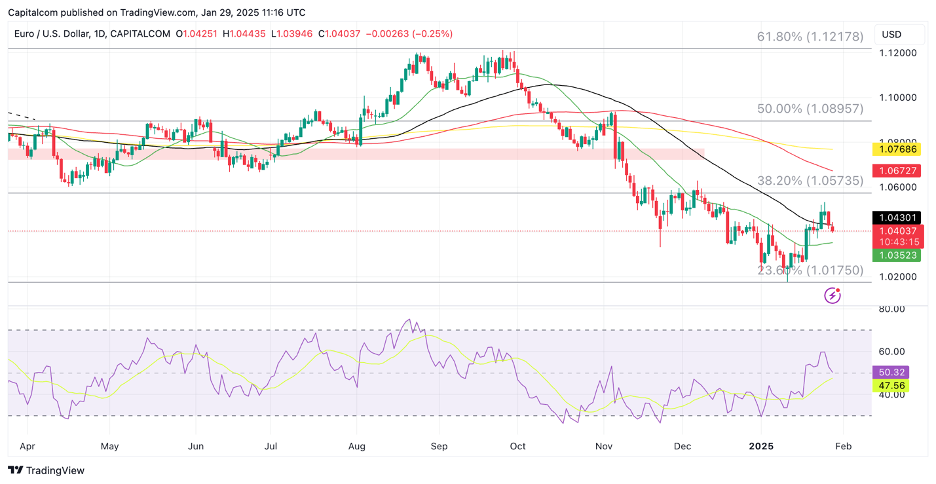The European Central Bank (ECB) is expected to cut rates again when they meet on Thursday. Markets have no doubt about that, with the odds leaning in favour of a 25 bps cut versus a 50 bps cut at 92% vs 8% respectively. Recent commentary from ECB Governing Council (GC) members, including President Christine Lagarde, reinforces expectations for further monetary easing. Speaking at the World Economic Forum in Davos last week, Lagarde defended the ECB’s rate-cutting trajectory while emphasizing the need for structural economic reforms in Europe.
Balancing Growth and Inflation Risks
Recent data suggests a potential risk of stagflation, with sluggish economic growth coinciding with an uptick in inflation. However, the ECB appears to view this inflationary resurgence as temporary. Even traditionally hawkish GC members have recently sounded more dovish, likely influenced by the central bank’s December projections, which assumed a terminal rate below 2%—implying 100 basis points of cuts from current levels. Additionally, concerns about European growth risks stemming from potential policy shifts under the Trump administration may be shaping the ECB’s cautious outlook.
In the long run, as long as inflation remains on a downward trajectory, the ECB is likely to overlook short-term price increases. Given that interest rates at 3% are still considered restrictive—particularly amid a weakening Eurozone economy—further rate cuts seem inevitable. Current market pricing suggests around 90 basis points of easing by December.
ECB Policy Outlook: Slow but Steady Easing
Rising bond yields have tightened financial conditions in Europe, adding further justification for a rate cut. However, Lagarde is expected to maintain a cautious approach, reiterating her stance from December and Davos: rates will remain in restrictive territory, but gradual easing is on the horizon. While she is unlikely to pre-commit to a specific easing path, the ECB will likely continue cutting rates at a measured pace to balance inflation risks with economic support.
The ECB aims to stay ahead of the curve while avoiding a scenario where rates fall too low too quickly. This measured approach will likely prevent an ultra-loose monetary policy but should see the bank return rates to neutral levels as swiftly as conditions allow.
Market Impact: Equities Benefit, Euro Struggles
The ECB’s dovish stance has provided a tailwind for European equities, with the STOXX 600 and DAX 40 emerging as clear outperformers in recent weeks. As momentum shifts from U.S. to European markets, further upside in European stocks remains a strong possibility.
In contrast, the euro continues to struggle against the US Dollar. EUR/USD has repeatedly failed to consolidate above 1.05, and the upcoming ECB meeting is unlikely to provide meaningful support for the currency. While the dollar has faced some selling pressure due to a fading “U.S. exceptionalism” narrative, structural weaknesses within the Eurozone economy are likely to keep the euro under pressure, limiting its ability to attract strong buying interest.
EUR/USD Daily Chart

Past performance is not a reliable indicator of future results.
Capital Com is an execution-only service provider. The material provided in this article is for information purposes only and should not be understood as investment advice. Any opinion that may be provided on this page does not constitute a recommendation by Capital Com or its agents. We do not make any representations or warranty on the accuracy or completeness of the information that is provided on this page. If you rely on the information on this page, then you do so entirely at your own risk.
Which stock should you buy in your very next trade?
With valuations skyrocketing in 2024, many investors are uneasy putting more money into stocks. Unsure where to invest next? Get access to our proven portfolios and discover high-potential opportunities.
In 2024 alone, ProPicks AI identified 2 stocks that surged over 150%, 4 additional stocks that leaped over 30%, and 3 more that climbed over 25%. That's an impressive track record.
With portfolios tailored for Dow stocks, S&P stocks, Tech stocks, and Mid Cap stocks, you can explore various wealth-building strategies.
